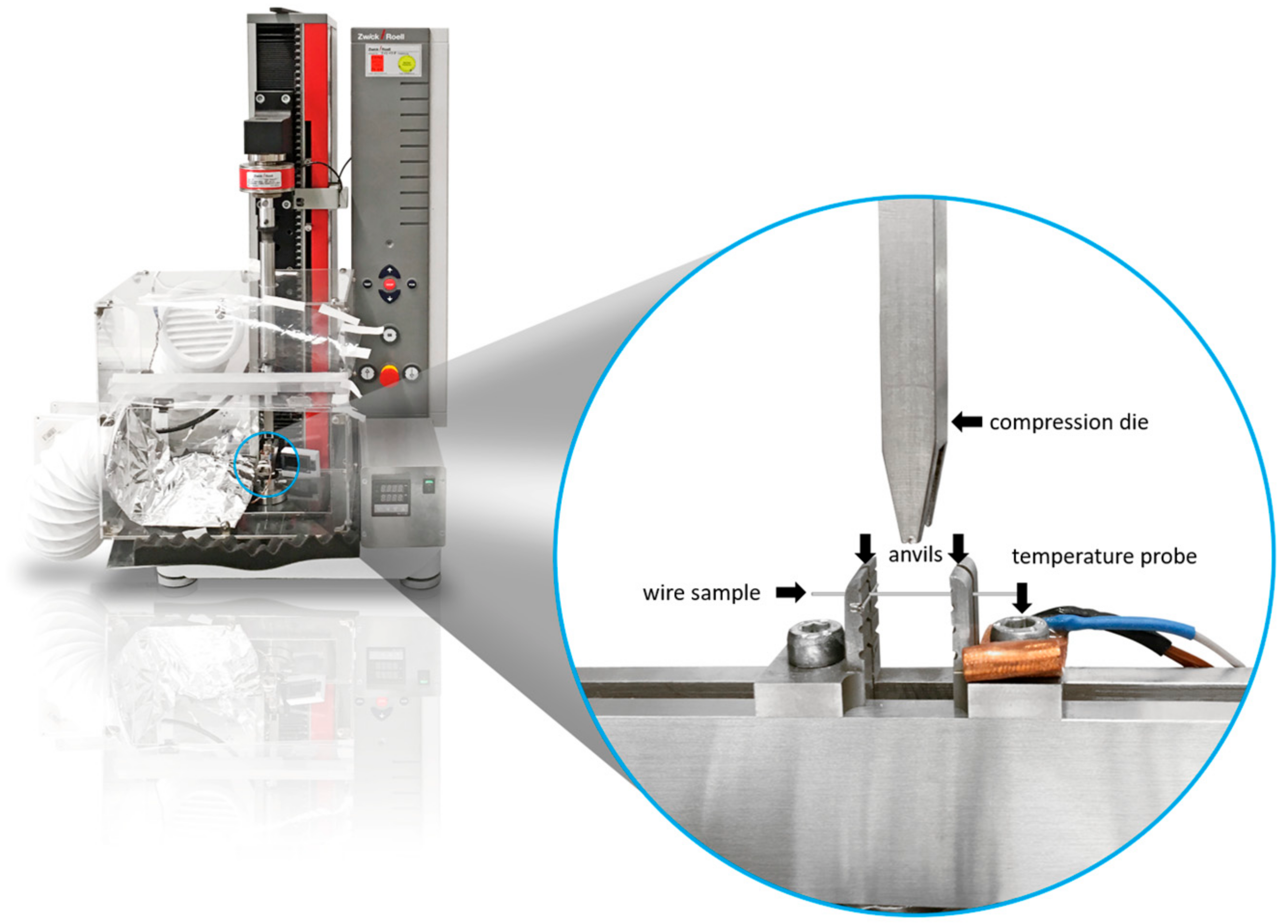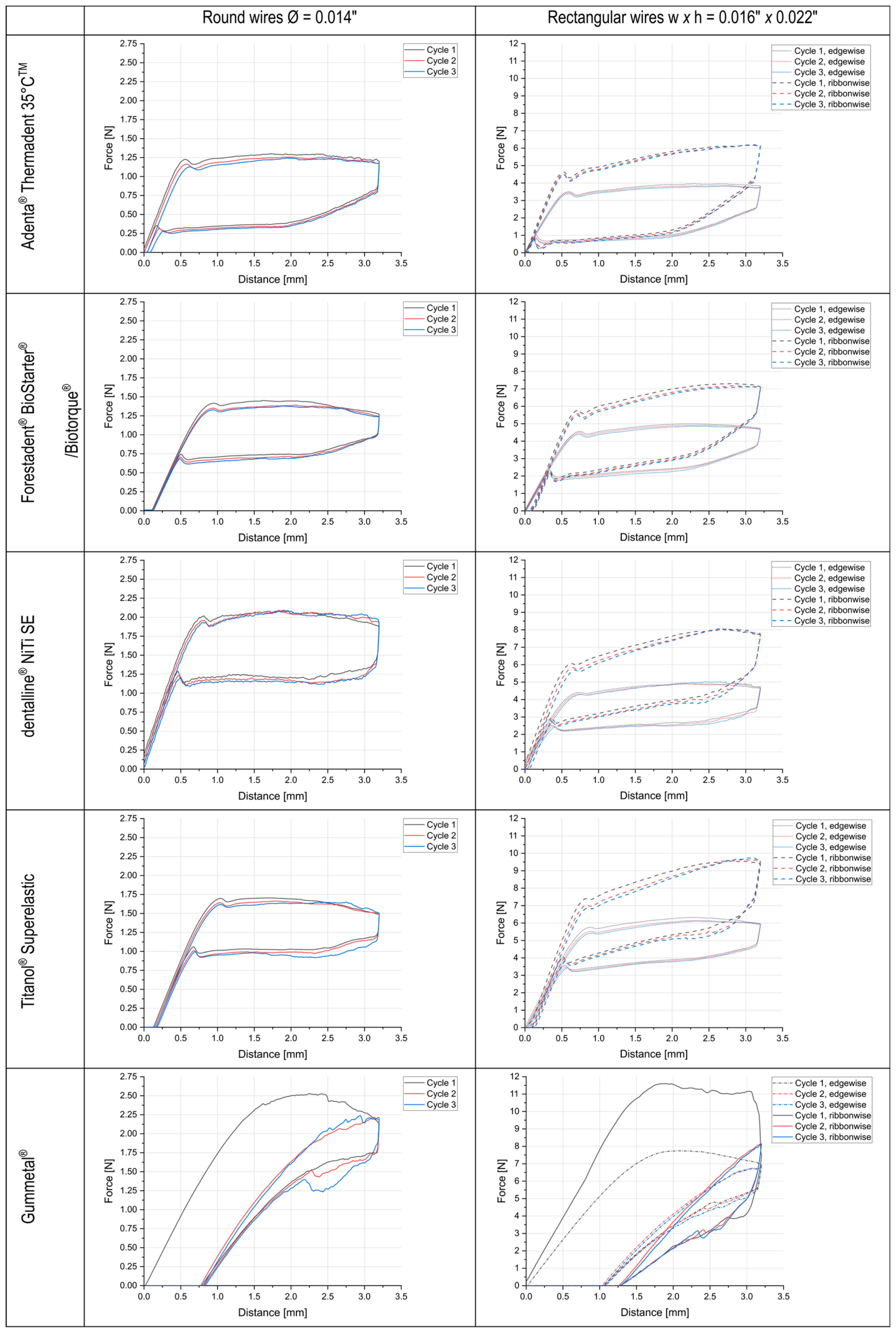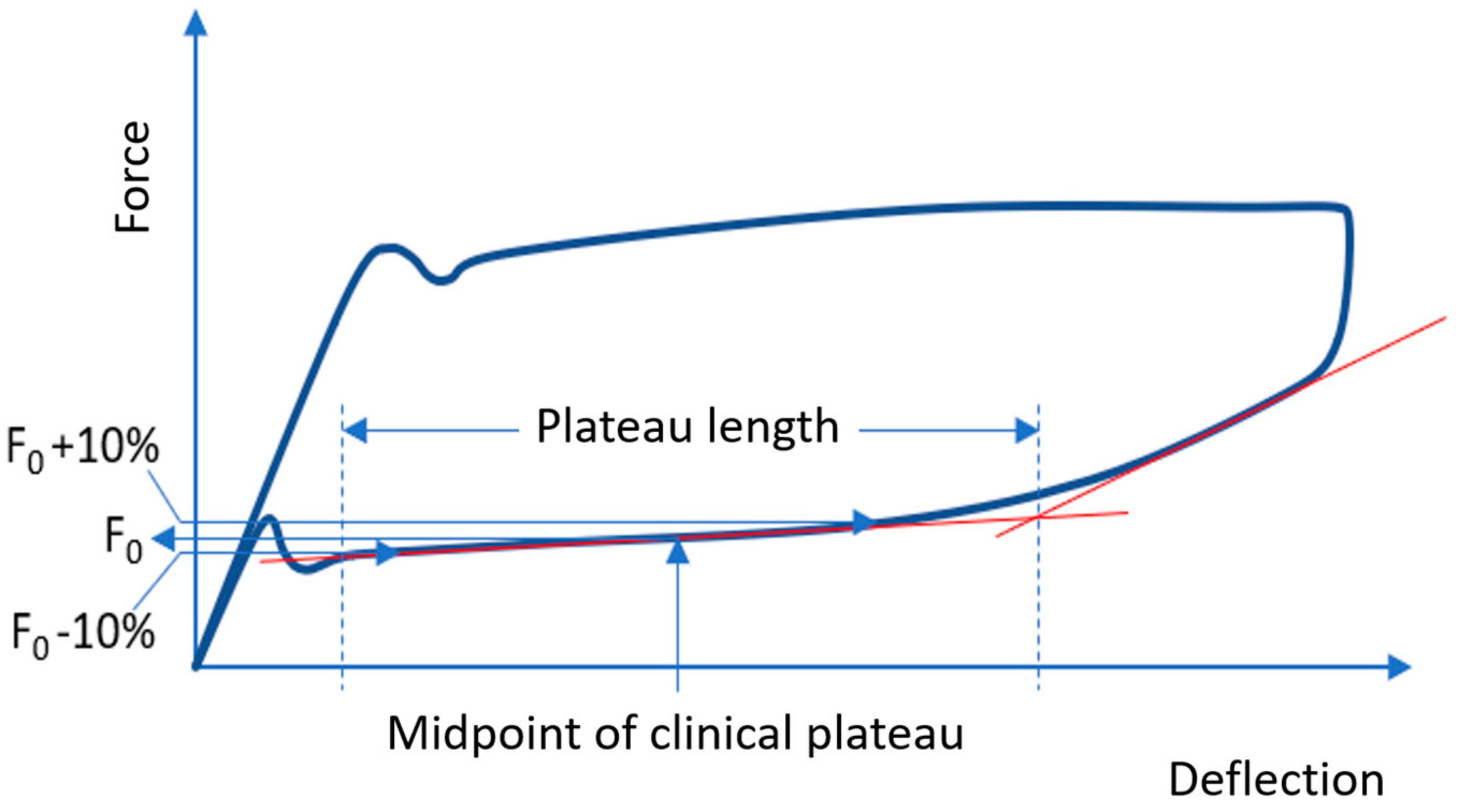Load Deflection Characteristics of Orthodontic Gummetal® Wires in Comparison with Nickel–Titanium Wires: An In Vitro Study
Abstract
1. Introduction
2. Materials and Methods
3. Results
4. Discussion
5. Conclusions
Author Contributions
Funding
Institutional Review Board Statement
Informed Consent Statement
Data Availability Statement
Conflicts of Interest
References
- Kusy, R.P. A review of contemporary archwires: Their properties and characteristics. Angle Orthod. 1997, 67, 197–207. [Google Scholar] [PubMed]
- Roscoe, M.G.; Meira, J.B.; Cattaneo, P.M. Association of orthodontic force system and root resorption: A systematic review. Am. J. Orthod. Dentofac. Orthop. 2015, 147, 610–626. [Google Scholar] [CrossRef] [PubMed]
- Yassir, Y.A.; McIntyre, G.T.; Bearn, D.R. Orthodontic treatment and root resorption: An overview of systematic reviews. Eur. J. Orthod. 2021, 43, 442–456. [Google Scholar] [CrossRef] [PubMed]
- Faltin, R.M.; Arana-Chavez, V.E.; Faltin, K.; Sander, F.-G.; Wichelhaus, A. Root resorptions in upper first premolars after application of continuous intrusive forces. Intra-individual study. J. Orofac. Orthop. 1998, 59, 208–219. [Google Scholar] [CrossRef] [PubMed]
- Kyprianou, C.; Chatzigianni, A.; Daratsianos, N.; Bourauel, C. Vertical and Orovestibular Forces Generated by Beta-Titanium and Stainless-Steel Rectangular Wires in Labial and Fully Customized Lingual Bracket Systems. Materials 2021, 14, 5632. [Google Scholar] [CrossRef] [PubMed]
- Janson, G.R.; de Luca Canto, G.; Martins, D.R.; Henriques, J.F.C.; de Freitas, M.R. A radiographic comparison of apical root resorption after orthodontic treatment with 3 different fixed appliance techniques. Am. J. Orthod. Dentofac. Orthop. 2000, 118, 262–273. [Google Scholar] [CrossRef]
- Nordstrom, B.; Shoji, T.; Anderson, W.C.; Fields, H.W.; Beck, F.M.; Kim, D.-G.; Takano-Yamamoto, T.; Deguchi, T. Comparison of changes in irregularity and transverse width with nickel-titanium and niobium-titanium-tantalum-zirconium archwires during initial orthodontic alignment in adolescents: A double-blind randomized clinical trial. Angle Orthod. 2018, 88, 348–354. [Google Scholar] [CrossRef]
- Abdelrahman, R.S.; Al-Nimri, K.S.; Al Maaitah, E.F. A clinical comparison of three aligning archwires in terms of alignment efficiency: A prospective clinical trial. Angle Orthod. 2015, 85, 434–439. [Google Scholar] [CrossRef]
- Brauchli, L.M.; Keller, H.; Senn, C.; Wichelhaus, A. Influence of bending mode on the mechanical properties of nickel-titanium archwires and correlation to differential scanning calorimetry measurements. Am. J. Orthod. Dentofac. Orthop. 2011, 139, e449–e454. [Google Scholar] [CrossRef]
- Kuntz, M.L.; Vadori, R.; Khan, M.I. Review of Superelastic Differential Force Archwires for Producing Ideal Orthodontic Forces: An Advanced Technology Potentially Applicable to Orthognathic Surgery and Orthopedics. Curr. Osteoporos. Rep. 2018, 16, 380–386. [Google Scholar] [CrossRef]
- Bartzela, T.N.; Senn, C.; Wichelhaus, A. Load-deflection characteristics of superelastic nickel-titanium wires. Angle Orthod. 2007, 77, 991–998. [Google Scholar] [CrossRef] [PubMed]
- Brantley, W.A. Evolution, clinical applications, and prospects of nickel-titanium alloys for orthodontic purposes. J. World Fed. Orthod. 2020, 9, S19–S26. [Google Scholar] [CrossRef]
- Proffit, W.R.; Fields, H.W.; Sarver, D.M. Contemporary Orthodontics, 6th ed.; Elsevier/Mosby: St. Louis, MO, USA, 2018. [Google Scholar]
- Nagasako, N.; Asahi, R.; Hafner, J. First-principles study of Gum-Metal alloys: Mechanism of ideal strength. R&D Rev. Toyota CRDL 2013, 44, 61–68. [Google Scholar]
- Hasegawa, S. A Concept of “En Bloc” Movement of Teeth Using GUMMETAL Wires. Informationen Orthod. Kieferorthopädie 2013, 45, 77–91. [Google Scholar]
- Gordin, D.M.; Ion, R.; Vasilescu, C.; Drob, S.I.; Cimpean, A.; Gloriant, T. Potentiality of the “Gum Metal” titanium-based alloy for biomedical applications. Mater. Sci. Eng. C Mater. Biol. Appl. 2014, 44, 362–370. [Google Scholar] [CrossRef] [PubMed]
- Schmeidl, K.; Janiszewska-Olszowska, J.; Grocholewicz, K. Clinical Features and Physical Properties of Gummetal Orthodontic Wire in Comparison with Dissimilar Archwires: A Critical Review. Biomed Res. Int. 2021, 2021, 6611979. [Google Scholar] [CrossRef] [PubMed]
- Murakami, T.; Iijima, M.; Muguruma, T.; Yano, F.; Kawashima, I.; Mizoguchi, I. High-cycle fatigue behavior of beta-titanium orthodontic wires. Dent. Mater. J. 2015, 34, 189–195. [Google Scholar] [CrossRef] [PubMed]
- Chang, H.P.; Tseng, Y.C. A novel beta-titanium alloy orthodontic wire. Kaohsiung J. Med. Sci. 2018, 34, 202–206. [Google Scholar] [CrossRef]
- Kopsahilis, I.E.; Drescher, D. Friction behavior of the wire material Gummetal(R). J. Orofac. Orthop. 2022, 83, 59–72. [Google Scholar] [CrossRef]
- Schmeidl, K.; Wieczorowski, M.; Grocholewicz, K.; Mendak, M.; Janiszewska-Olszowska, J. Frictional Properties of the TiNbTaZrO Orthodontic Wire-A Laboratory Comparison to Popular Archwires. Materials 2021, 14, 6233. [Google Scholar] [CrossRef]
- Zhou, A. Effects of various coating methods on the mechanical, physical, and aesthetic properties of GUMMETAL(R) archwires: In vitro study. Int. Orthod. 2023, 21, 100753. [Google Scholar] [CrossRef] [PubMed]
- Nahás-Scocate, A.C.R.; Neves, M.B.; de Souza, L.T.; de Cerqueira Kasaz, A.; Listik, E.; da Silva, H.D.P.; Cattaneo, P.M.; Scocate, M.C.; Bordin, D.; Matias, M. An in vitro assessment of the influences of different wire materials and bracket systems when correcting dental crowding. J. Mater. Sci. Mater. Med. 2020, 31, 108. [Google Scholar] [CrossRef] [PubMed]
- Hasegawa, S. A New Super Elasto-Plastic Ti Alloy (Gummetal) Simplifies Treatment Procedure, Scientific Report of Rocky Mountain MORITA; Rocky Mountain MORITA: Tokyo, Japan, 2010; pp. 1–8. [Google Scholar]
- Liu, J.-P.; Wang, Y.-D.; Hao, Y.-L.; Wang, Y.; Nie, Z.-H.; Wang, D.; Ren, Y.; Lu, Z.-P.; Wang, J.; Wang, H.; et al. New intrinsic mechanism on gum-like superelasticity of multifunctional alloys. Sci. Rep. 2013, 3, 2156. [Google Scholar] [CrossRef]
- Saito, T.; Furuta, T.; Hwang, J.H.; Kuramoto, S.; Nishino, K.; Suzuki, N.; Chen, R.; Yamada, A.; Ito, K.; Seno, Y.; et al. Multifunctional Alloys Obtained via a Dislocation-Free Plastic Deformation Mechanism. Science 2003, 300, 464–467. [Google Scholar] [CrossRef] [PubMed]
- DIN ISO 15841:2014 + Amd 1:2020; Dentistry—Wires for Use in Orthodontics (ISO 15841:2014 + Amd 1:2020). German version EN ISO 15841:2014 + A1:2020. International Organization for Standardization: Geneva, Switzerland, 2021.
- ISO 15821; Doorsets and Windows: Water-Tightness Test under Dynamic Pressure Cyclonic Aspects. ISO: Geneva, Switzerland, 2007.
- Field, A. Discovering Statistics Using SPSS; SAGE Publications: Thousand Oaks, CA, USA, 2009. [Google Scholar]
- Nikolai, R.J. Orthodontic wire: A continuing evolution. Semin. Orthod. 1997, 3, 157–165. [Google Scholar] [CrossRef] [PubMed]
- Bantleon, H.; Droschl, H.; Stern, G. Different applications of various wire alloys in fixed appliance technic. Informationen Orthod. Kieferorthopädie 1989, 21, 173–183. [Google Scholar]
- Miura, F.; Mogi, M.; Ohura, Y.; Hamanaka, H. The super-elastic property of the Japanese NiTi alloy wire for use in orthodontics. Am. J. Orthod. Dentofac. Orthop. 1986, 90, 1–10. [Google Scholar] [CrossRef]
- Kuramoto, S.; Furuta, T.; Hwang, J.H.; Nishino, K.; Saito, T. Plastic deformation in a multifunctional Ti-Nb-Ta-Zr-O alloy. Metall. Mater. Trans. A 2006, 37, 657–662. [Google Scholar] [CrossRef]
- Hasegawa, S. A New Super Elasto-Plastic Ti Alloy-GUMMETAL-Simplify Treatment Procedure, Clinical Use of Gummetal; Rocky Mountain MORITA: Tokyo, Japan, 2010; pp. 1–8. [Google Scholar]
- Talling, R.; Dashwood, R.; Jackson, M.; Dye, D. On the mechanism of superelasticity in Gum metal. Acta Mater. 2009, 57, 1188–1198. [Google Scholar] [CrossRef]
- Morris, J.W., Jr.; Hanlumyuang, Y.; Sherburne, M.; Withey, E.; Chrzan, D.C.; Kuramoto, S.; Hayashi, Y.; Hara, M. Anomalous transformation-induced deformation in textured Gum Metal. Acta Mater. 2010, 58, 3271–3280. [Google Scholar] [CrossRef]
- Withey, E.; Jin, M.; Minor, A.; Kuramoto, S.; Chrzan, D.C.; Morris, J.W., Jr. The deformation of “Gum Metal” in nanoindentation. Mater. Sci. Eng. A 2008, 493, 26–32. [Google Scholar] [CrossRef]
- Furuta, T.; Kuramoto, S.; Hwang, J.; Nishino, K.; Saito, T. Elastic deformation behavior of multi-functional Ti–Nb–Ta–Zr–O alloys. Mater. Trans. 2005, 46, 3001–3007. [Google Scholar] [CrossRef]
- Kazuaki, N. Super Multifunctional Alloy GUM METAL. Toyota Central R and D Lab. Tech. J. R&D Rev. 2003, 38, 50. [Google Scholar]
- Kapila, S.; Sachdeva, R. Mechanical properties and clinical applications of orthodontic wires. Am. J. Orthod. Dentofac. Orthop. 1989, 96, 100–109. [Google Scholar] [CrossRef] [PubMed]
- Fuck, L.M.; Drescher, D. Force systems in the initial phase of orthodontic treatment—A comparison of different leveling arch wires. J. Orofac. Orthop. 2006, 67, 6–18. [Google Scholar] [CrossRef]



| Manufacturer | Trade Name | Wire Dimension | ||
|---|---|---|---|---|
| 0.014″ | 0.016″ × 0.022″ | |||
| Round | Edgewise | Ribbonwise | ||
| Adenta® | Thermadent 35 °C™ | X | X | X |
| Forestadent® | BioStarter® | X | ||
| Forestadent® | Biotorque® | X | X | |
| dentalline® | NiTi SE | X | X | X |
| Forestadent® | Titanol® Superelastic | X | X | X |
| J. Morita Europe | Gummetal® | X | X | X |
| Model | Directionality | Force Level at 2.0 mm Deflection [N] | Force Level at 1.0 mm Deflection [N] | ||||||||
|---|---|---|---|---|---|---|---|---|---|---|---|
| Mean (SD) | Min | Max | Md | p-Value | Mean (SD) | Min | Max | Md | p-Value | ||
| Adenta® Thermadent 35 °C™ | round | 0.40 (0.01) | 0.40 | 0.43 | 0.40 | 0.002 | 0.37 (0.02) | 0.35 | 0.4 | 0.36 | 0.002 |
| Forestadent® BioStarter® | round | 0.73 (0.02) | 0.71 | 0.76 | 0.73 | 0.002 | 0.70 (0.02) | 0.67 | 0.73 | 0.70 | 0.002 |
| dentalline® NiTi SE | round | 1.21 (0.04) | 1.15 | 1.26 | 1.21 | 0.009 | 1.19 (0.02) | 1.15 | 1.22 | 1.19 | 0.002 |
| Forestadent® Titanol® Superelastic | round | 1.00 (0.04) | 0.95 | 1.06 | 1.01 | 0.002 | 0.99 (0.03) | 0.94 | 1.03 | 0.99 | 0.002 |
| Gummetal® | round | 1.33 (0.05) | 1.24 | 1.37 | 1.34 | ref. | 0.28 (0.04) | 0.21 | 0.31 | 0.29 | ref. |
| Model | Directionality | Force Level at 2.0 mm Deflection [N] | Force Level at 1.0 mm Deflection [N] | ||||||||
|---|---|---|---|---|---|---|---|---|---|---|---|
| Mean (SD) | Min | Max | Md | p-Value | Mean (SD) | Min | Max | Md | p-Value | ||
| Adenta® Thermadent 35 °C™ | edgewise | 1.02 (0.01) | 1.01 | 1.04 | 1.01 | 0.002 | 0.79 (0.01) | 0.77 | 0.81 | 0.79 | 0.002 |
| Forestandent® BioTorque® | edgewise | 2.12 (0.4) | 1.32 | 2.42 | 2.24 | 0.002 | 1.84 (0.37) | 1.09 | 2.11 | 1.95 | 0.002 |
| dentalline® NiTi SE | edgewise | 2.69 (0.1) | 2.61 | 2.86 | 2.65 | 0.002 | 2.47 (0.1) | 2.37 | 2.6 | 2.43 | 0.002 |
| Forestadent® Titanol® Superelastic | edgewise | 3.88 (0.08) | 3.75 | 3.99 | 3.88 | 0.002 | 3.49 (0.07) | 3.37 | 3.6 | 3.5 | 0.002 |
| Gummetal® | edgewise | 3.41 (0.08) | 3.26 | 3.48 | 3.44 | ref. | 0 (0) | 0 | 0 | 0 | ref. |
| Adenta® Thermadent 35 °C™ | ribbonwise | 1.34 (0.04) | 1.28 | 1.38 | 1.34 | 0.002 | 0.87 (0.04) | 0.83 | 0.91 | 0.88 | 0.002 |
| Forestandent® BioTorque® | ribbonwise | 3.18 (0.1) | 3.05 | 3.32 | 3.17 | 0.002 | 2.45 (0.09) | 2.33 | 2.56 | 2.44 | 0.002 |
| dentalline® NiTi SE | ribbonwise | 3.98 (0.12) | 3.84 | 4.15 | 3.98 | 0.002 | 3.19 (0.1) | 3.07 | 3.3 | 3.2 | 0.002 |
| Forestadent® Titanol® Superelastic | ribbonwise | 5.28 (0.1) | 5.18 | 5.41 | 5.28 | 0.002 | 4.43 (0.06) | 4.35 | 4.53 | 4.43 | 0.002 |
| Gummetal® | ribbonwise | 2.44 (0.33) | 2.11 | 2.9 | 2.43 | ref. | 0 (0) | 0 | 0.01 | 0 | ref. |
Disclaimer/Publisher’s Note: The statements, opinions and data contained in all publications are solely those of the individual author(s) and contributor(s) and not of MDPI and/or the editor(s). MDPI and/or the editor(s) disclaim responsibility for any injury to people or property resulting from any ideas, methods, instructions or products referred to in the content. |
© 2024 by the authors. Licensee MDPI, Basel, Switzerland. This article is an open access article distributed under the terms and conditions of the Creative Commons Attribution (CC BY) license (https://creativecommons.org/licenses/by/4.0/).
Share and Cite
Sabbagh, H.; Janjic Rankovic, M.; Martin, D.; Mertmann, M.; Hötzel, L.; Wichelhaus, A. Load Deflection Characteristics of Orthodontic Gummetal® Wires in Comparison with Nickel–Titanium Wires: An In Vitro Study. Materials 2024, 17, 533. https://doi.org/10.3390/ma17020533
Sabbagh H, Janjic Rankovic M, Martin D, Mertmann M, Hötzel L, Wichelhaus A. Load Deflection Characteristics of Orthodontic Gummetal® Wires in Comparison with Nickel–Titanium Wires: An In Vitro Study. Materials. 2024; 17(2):533. https://doi.org/10.3390/ma17020533
Chicago/Turabian StyleSabbagh, Hisham, Mila Janjic Rankovic, Daniel Martin, Matthias Mertmann, Linus Hötzel, and Andrea Wichelhaus. 2024. "Load Deflection Characteristics of Orthodontic Gummetal® Wires in Comparison with Nickel–Titanium Wires: An In Vitro Study" Materials 17, no. 2: 533. https://doi.org/10.3390/ma17020533
APA StyleSabbagh, H., Janjic Rankovic, M., Martin, D., Mertmann, M., Hötzel, L., & Wichelhaus, A. (2024). Load Deflection Characteristics of Orthodontic Gummetal® Wires in Comparison with Nickel–Titanium Wires: An In Vitro Study. Materials, 17(2), 533. https://doi.org/10.3390/ma17020533







